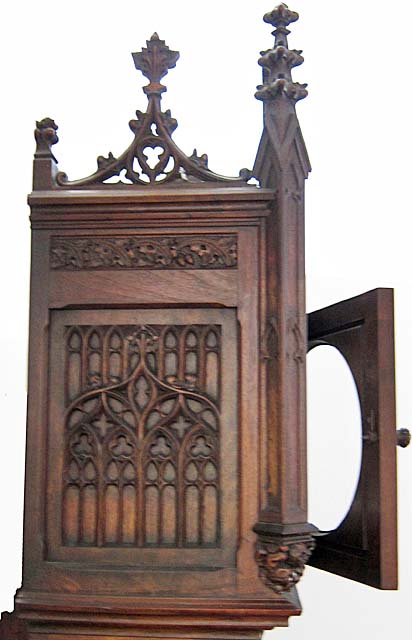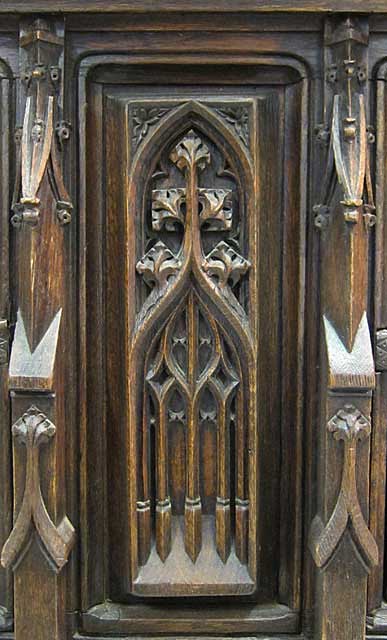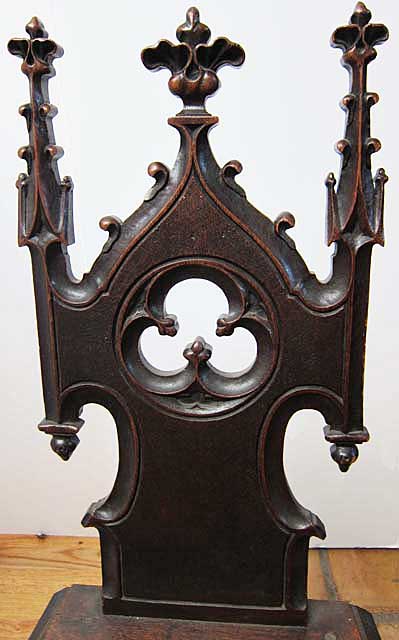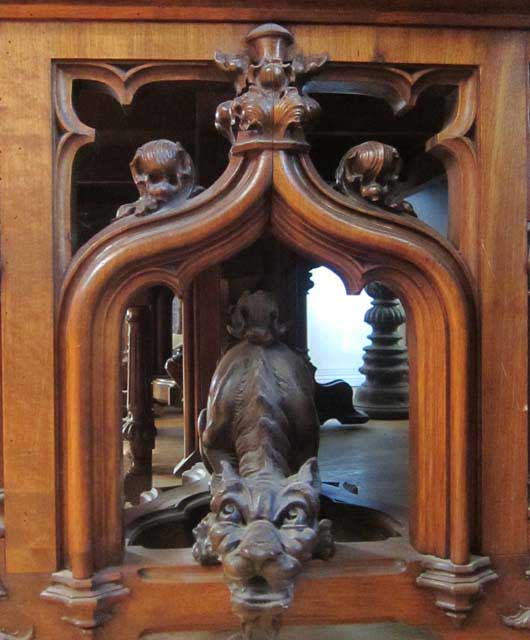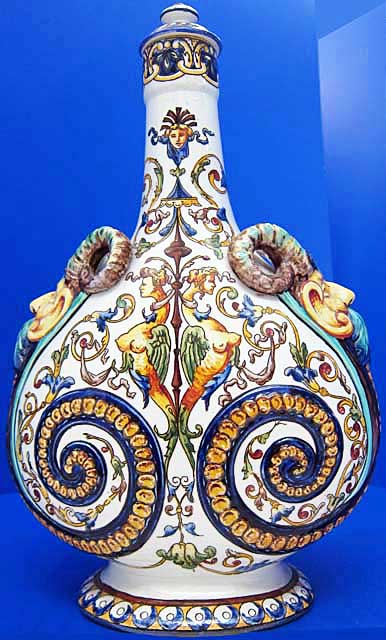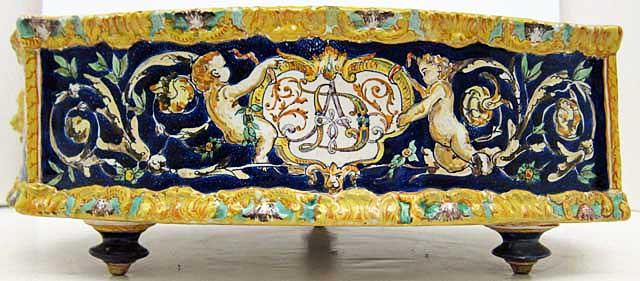Over years of writing descriptions of the furniture we offer, this web page has evolved as an attempt to explain what we love about 19th century French furniture reviving the styles of the earlier Gothic and Renaissance periods. They speak to us as other styles do not, whether the solid construction, the intricate carving, or the inherent beauty of the overall designs. Perhaps the greatest testament to the talented designers and craftsmen of 19th century France is that it is not necessary to know any of this — as we did not in order to enjoy the furniture and to welcome it into one's home. For those wishing to delve beyond this web page, there is a Bibliography of useful publications, below, following Michael Markley's commentary on caring for antique furniture.
During my student days at Vassar College, I never dreamed that my passion for the Neo-Gothic furniture in Skinner Hall would lead me to a sojourn in Paris where my husband, Michael, fell in love with antiques and our business was born. What started as the desire to furnish our bare-bones apartment, with items in the heavily carved styles known as Neo-Gothique and Neo-Renaissance from the Antiques Market at Saint-Ouen, led to collecting and then selling the extraordinary items we found there and elsewhere in France.
Art historians recount how Renaissance style surged north from Italy like a tidal wave, in the late 15th through early 17th centuries, sweeping aside the entrenched Gothic style as it sped toward the English Channel and beyond. By contrast, the revivals of these two styles during the latter half of the 19th century in France behaved very differently. They coexisted for a time, converging into an amalgam labeled Henri II for the king who reigned from 1547 to 1559. What united them in the imagination of furniture designers was a reverence for what had been accomplished centuries earlier including the exquisite carving by hand of decorative elements in furniture made of oak and walnut. Examples from the two earlier periods (termed collectively in French as the haute époque) in museums and private collections throughout northern France provided lots to copy, as did prints and engravings of furniture designs circulating since the 16th century. The following cabinet from our collection is a 19th century copy, almost an exact replica, of a 16th century one documented in the collection of the Cluny Museum in Paris.

To the makers of furniture in the two earlier time periods, elements requiring great skill and costly materials in their creation proclaimed the wealth and erudition of owners, whether ecclesiastical or noble. In a time when life was short and could end suddenly, ornament was luxury and elaborate detail spelled enjoyment in the here and now — for those who could afford it. Even to the extent that Renaissance style could be considered a repudiation of the Gothic, such that rounded arches and spiraling tendrils replaced pointed arches and complex tracery, exquisitely carved furniture continued to be prized, including during the 19th century revival of these styles.
In a time of rapid industrialization in the late 19th century, with the introduction of items turned out cheaply and quickly by factories, the furniture-buying public appreciated that no machine could replicate what only a human artist could fashion by hand in Gothic and Renaissance Revival styles. Both revivals flourished contemporaneously until the onset of the Great War, satisfying buyers’ desires to live amidst the beauty of handmade furniture harking back to an earlier time while celebrating a passion shared across centuries.
As scholars (and dealers) have learned, the passion for possessing furniture of the Middle Ages and Renaissance in the 19th century led to "repurposing" elements of older pieces as well as the creation of outright fakes passed off as items from earlier times. This included incorporating panels from chests and cabinets into new furniture meant to evoke earlier styles. These new items, now in the 21st century, have become antiques in their own right. Fascinating discussions and graphic illustrations of this practice are found in the publications of Agnès Bos, listed in the Bibliography, below. For an example in our collection of just such re-purposing, see Breton Cabinet 5223.
When seeking to recreate the past, some mistaken assumptions were made and persist to this day. Both English and French furniture-makers and antique dealers in the 19th century believed that pieces dating from the Middle Ages and Renaissance were dark, whether due to centuries of built-up paste wax mixed with smoke, or just from personal preferences and use of stains. As scholars now know, to the extent that furniture made in the Middle Ages and the Renaissance was stained, it was only lightly so. The natural beauty of the wood was admired and so it was finished with a light varnish and then waxed. Nevertheless, 19th century dealers and collectors persisted in their desire for darkly colored furniture and interiors evoking the obscurity and mystery of earlier times while convinced that such interiors should protect them from intrusions of light from the outside world.
Our collection of 19th century French furniture evokes the spirit of Europe’s master designers and cabinet-makers whose scrupulous attention to detail and use of the finest materials speak to us across the centuries as we welcome these pieces into today’s homes and businesses. Despite wars, pestilence and other attacks on the furniture and the people who owned it, those examples that survive are an ongoing tribute to the genius of their creators.
We will now step back in time to discover what made furniture "Gothic" or "Renaissance" in style during the 12th through the 17th centuries, even though those terms were not used back then. Gothic style furniture, more so than Renaissance, derived its elements directly from architecture. Renaissance style furniture, more so than Gothic, had its roots in decorative elements of Roman art used in any number of applications. With its humanist overtones, Renaissance art centered more on individuals and their relationships, including with the elements of style central to the period.
We had the rare opportunity to see some of this furniture outside the confines of a museum and even to touch it. Tracing the strokes of the artisans' tools with our own fingers while marveling, up close, at the magnificence of the carving completed 500 years ago, we were dazzled. This happened in 1992 at the preview for the sale at auction in Paris of part of the collection amassed by Bruno Perrier, one of the world's foremost experts on Haute Epoque furniture.
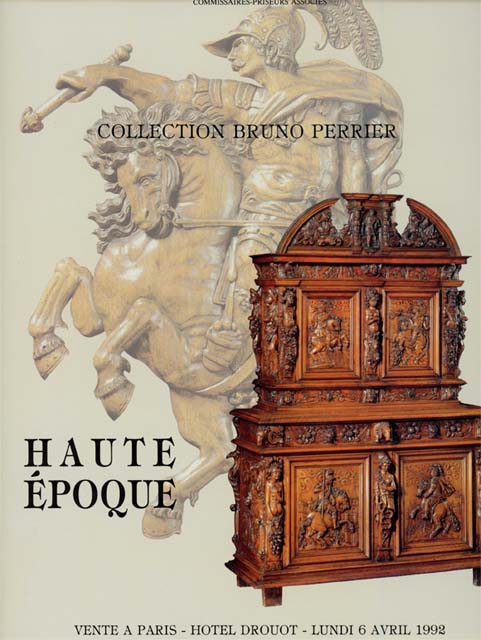
Not only were the items offered for sale from the Perrier Collection quite pricey and of museum quality, but under France's rules for protecting its patrimony would probably not have been allowed to leave the country with us when we moved back to the U.S. later in 1992. Fortunately, revival of interest in Gothic style furniture in the 19th century yielded more affordable items whose exportation was not limited. As a result, we found that the focus of our business skipped over hundreds of years and over dozens of other styles to arrive at Gothic Revival as embraced in the 19th century. The technical mastery of the stylistic elements and the faithful execution of carving no machine could ever mimic combine to bring the spirit of the earlier time to items we offer from the 19th century for the 21st century collectors who treasure them.
Gothic
Parts of the European continent in the late 12th century were enjoying levels of economic activity unseen since Roman times, spurred by trade, free markets, and the harnessing of water power. In their midst, a new style of architecture swept across northern France with an unprecedented vocabulary of stylistic elements used to fill vast spaces and to ornament new structural forms. As explained in the television show Building the Great Cathedrals (first broadcast in the Nova series in 2010 and re-issued in the aftermath of the fire at Notre Dame de Paris in 2019), this new style revolutionized architecture with three key elements: the pointed arch, the flying buttress, and the ribbed vault. These allowed for taller structures, thinner walls, and the admission of light through massive windows including those made of stained glass. First seen at Saint-Dénis, the basilica outside Paris where the kings of France were laid to rest, perhaps its greatest manifestation is at Notre Dame de Paris, the cathedral at the heart of the revival of interest in Gothic style in the 19th century. But we are getting ahead of ourselves. At first, this new style of the Middle Ages was referred to as "modern" or simply as opus francigenum or "French work" before being saddled later with what was intended to be a pejorative term, "Gothic." It referred to the Goths, a Germanic tribe who had pillaged their way through Europe several centuries earlier without contributing any audacious architectural style.
In a land where its predecessor, Romanesque architecture, had been utilitarian, functional, and fortress-like, characterized by rounded or "Roman" arches and thick stone walls with little in the way or ornamentation, the new style proved a feast for the eyes. Economic success spurred the generosity of royalty, nobility, and everyone else to finance projects such as cathedrals, whose construction lasted far beyond any one lifetime. Furniture-makers joined in, crafting cabinets, chests, chairs, and tables using the same design elements as the cathedral-builders. Individuals who did not live near a cathedral could still have a taste of one in their homes and enjoy this furniture incorporating the elements of Gothic style in oak and walnut. We like to think that time spent contemplating the beauty of this furniture could be almost as inspiring as a visit to a cathedral.
It is as if the lightness, height, and religious purpose of cathedrals erected in the new style had freed the imagination of craftsmen in stone to fill spaces with tracery or fenestrage (from the French word for "window") including soufflets, and mouchettes articulated with cusps and ornamented with crocketing (curled acanthus leaves ornamenting arches). These same elements were adopted by furniture-makers. As the following illustration shows, the mouchette is a curved figure with points at both ends or with one end having a rounded shape. The soufflet is distinguishable because it is symmetrical rather than curved. The term comes from the French for a bellows whose characteristic shape is rounded on one side but pointed on the other.
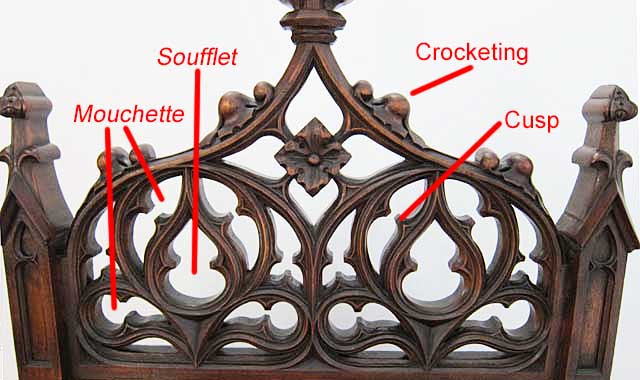
The workhorse of Gothic design in both architecture and furniture, is the lancet arch. It terminates in a point at the top with indentations, in the form of cusps, just below the top. The lancet arch derived from the Moorish arch (also known as the horseshoe arch), as the following graphic demonstrates. The red outline of the narrower lancet arch derives from overlapping broader Moorish arches outlined in pink and blue.
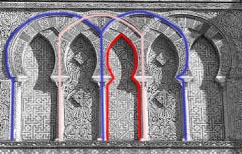
Lancet arches come in all shapes and sizes and are used in numerous ways. In their masonry form they march like soldiers along the base below stained glass rose windows as in the north and south transepts of Notre Dame de Paris. They may also appear alone, and in a squatty form, on corner blocks of cabinets.
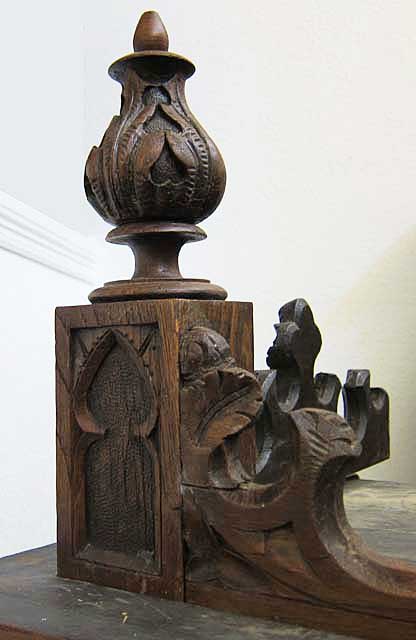
When multiplied and in their taller version, they are often arrayed in graduated sizes forming rows below other shapes of Gothic tracery including rose window designs and quatrefoils. The following examples show some of the thinnest lancet arches we have ever seen. One features open tracery where the wood has been carved away from the interior of the arches.

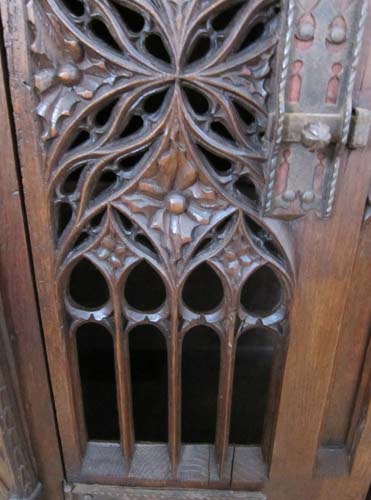
Supremely decorative in nature is the rosace or circular design inspired by the rose windows of Gothic cathedrals. As interpreted for furniture, the designs may be filled simply with mouchettes and soufflets or involve more complex patterns evoking stained glass windows.
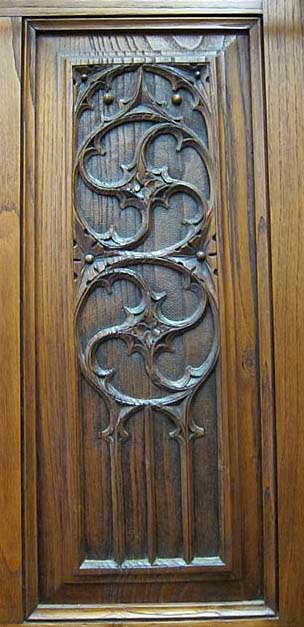
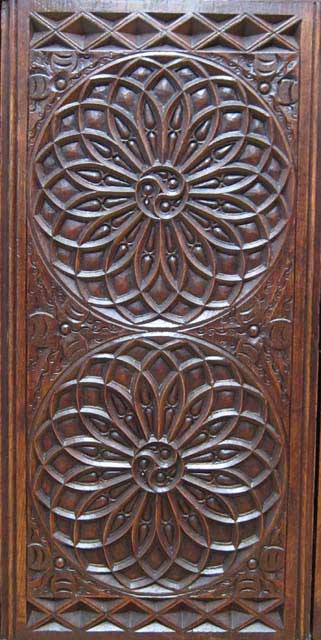
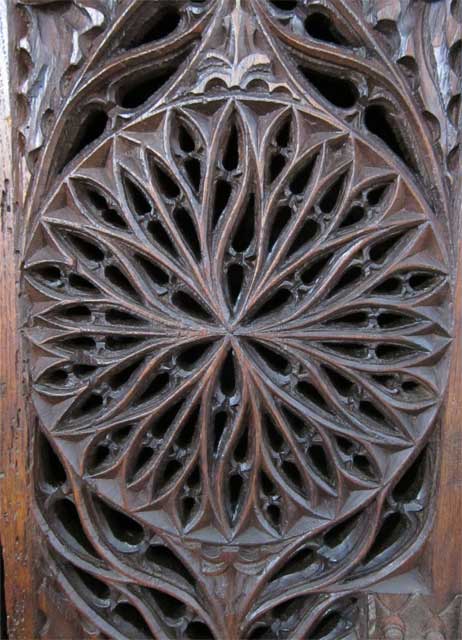
Flamboyant Gothic
The Gothic style persisted in northern Europe long after architecture and furniture inspired by the Renaissance (also a label created later in time) surged northward from Florence and adopted enthusiastically by French kings such as François I and Henri II (and Henri's Queen, the Florentine native Catherine de' Medici). Gothic's final gasp came in what is termed "Flamboyant Gothic." Quite elaborate, as the name would imply in English, what makes the style flamboyant as coined in the late 15th century is the use of the ogee (ogive) or S-shaped arch whose gracefully curved top ends in a point tapered to resemble a flame or flambe, in Old French. This point can take many shapes, including a fleur-de-lys, but the resemblance to the flambe is what led the style to be characterized as flamboyant.
The following is an example from the Louvre Museum, which has an extensive collection of Flamboyant Gothic furniture on display.
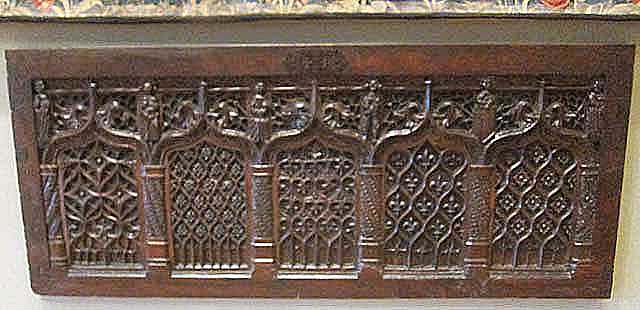
Examples of flamboyant arches, as interpreted by furniture designers in 19th century France, include the following elements from items in our collection:
With the most intricate of carving and tracery, the flamboyant took Gothic design to the end of the line, making France susceptible to a new vocabulary of style based on that of ancient Rome. Sweeping northward across the Alps with the return of France's kings from conquests in Italy, the Renaissance style took hold thanks to the Italian artists working for the royal court, as well as those who owned workshops in Lyon, and the generations of Frenchmen they trained.
The 19th Century Gothic Revival in France
As with other design movements, the 19th century revival of interest in the Middle Ages was shaped by political, social, and economic events. The French Revolution caused huge disruptions in the hereditary aristocracy along with the dispersal and destruction of families' fortunes, including their furniture. The subsequent years of Napoleon’s conquests in Europe devastated populations and their furniture. With Wellington’s victory came waves of British would-be collectors, like locusts devouring a crop of wheat, buying furniture at fire-sale prices and even chartering their own ships to haul it home from the Continent. This harvest of chattels involved the destruction of buildings, especially Gothic churches, where architectural elements were considered fair game for enthusiasts wishing to add a Gothic flavor to existing buildings or to include a ruin in their garden.
While such wholesale transfers of wealth from one country to another are rare, in the case of French furniture in England, it can be argued that preservation and admiration were fortunate byproducts. As Clive Wainwright demonstrated in his fascinating book, The Romantic Interior, collecting was no longer limited to the nobility but trickled down to the merchant class and the upwardly mobile. Such literary luminaries as Sir Walter Scott and Horace Walpole adored the Gothic style and collected passionately to create the romance of the Middle Ages in their homes without sacrificing modern conveniences for the primitive standard of living and technology in medieval times. Collectors became patrons and protectors, studiously cataloguing their collections and opening their homes to visitors.
During the 19th century, France too was swamped by waves of enthusiasm for earlier styles. These went by various names, including those attributed to Kings Henri II (reigned 1547-1559) and Louis XIII (reigned 1610-1643). As in England, the Gothic Revival in France was closely associated with literature, especially the works of the devoted collector of Gothic style furniture, Victor Hugo. It enjoyed the indulgence of royalty. The Duchesse de Berry embraced and encouraged what was called the Troubadour Style or Cathedral Style of Gothic Revival on exhibit at French industrial and trade fairs in the 19th century.
The shift in tastes from Empire, with its elaborate veneers and ormolu, to Gothic Revival with its more massive and architectural look, also reflects the importance of individual collectors and the expansion of the ranks of the bourgeoisie seeking to validate newly accumulated wealth with timeless furniture. Some Paris-based collectors, such as Emile Gavet, were also dealers and amassed large collections. These combined furniture and other decorative items dating from the Middle Ages and Renaissance, lumped together as haute époque. Some items from the Gavet collection have ended up in the Ringling Museum of Art in Sarasota, Florida and turned out to have been made in the 19th century rather than the 16th. For more about this, see Agnès Bos's chapter in Brilliant, below.
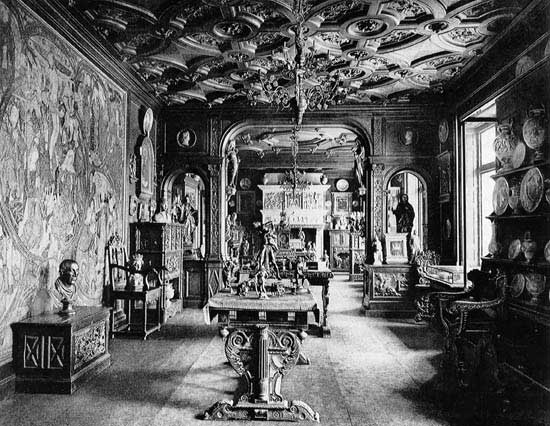
Photo of Emile Gavet's Collection in Paris (1889),
As political stability returned intermittently to France in the 19th century, the Gothic Revival became enmeshed with a movement by leading intellectuals and artists to conserve the country’s artistic heritage. In 1830, a government department was established to preserve and protect national treasures including the medieval city of Carcassone and to restore buildings such as Notre Dame de Paris under the supervision of Eugène Viollet-le-Duc. Even the King of France, Louis Philippe (reigned 1830-1848), indulged his passion for earlier times. He embraced 19th century industrial techniques to popularize the revival of furniture in the Gothic and Renaissance styles, particularly in connection with the renovation of his residence, the Château de Pau, in southwestern France.
The key stylistic elements of French Gothic Revival furniture include items adopted directly from architecture: the pointed arch; the linen-fold panel (pli de serviette or pli de parchemin); spires and columns (including fluted and twisted); tracery or fenestrage comprised of overall shapes such as arches or circles filled with quatrefoils, trefoils, rosettes, soufflets, and mouchettes; vegetation (vines, grapes, sunflowers, etc.).
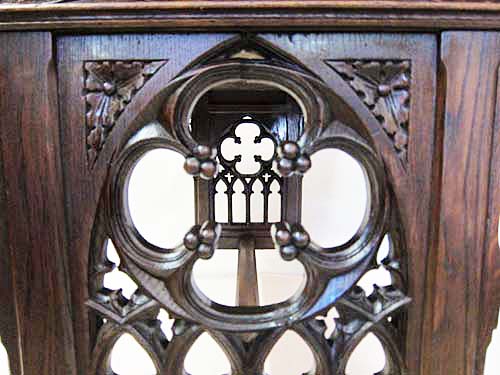
Like their forbears in the Middle Ages, designers had a sense of humor and playfulness whether in the human figures or the animals they included in architecture and furniture.
Medieval stone masons often included portraits of themselves, co-workers, or comic figures when crafting Gothic buildings. Sometimes they were hidden from view in chapels or atop clusters of columns. Other times they were in plain sight, prompting viewers to wonder about them. Some of our favorites are found in the Church of Saint-Nicolas in Blois in the Loire Valley. Not a cathedral but rather built for a monastery, this fascinating church is a contemporary of Chartres but a fascinating combination of Romanesque elements and Gothic design in a period when architects were still trying to work it all out. Designers of 19th century French furniture knew these figures and were inspired by them as we see in some of our pieces.
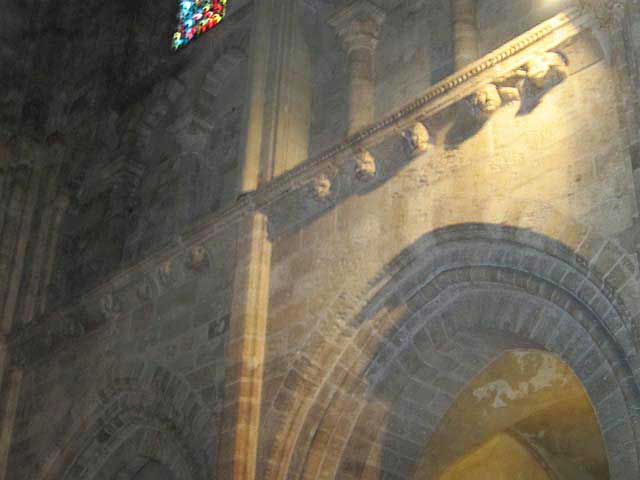
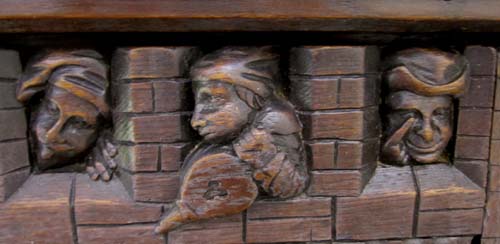
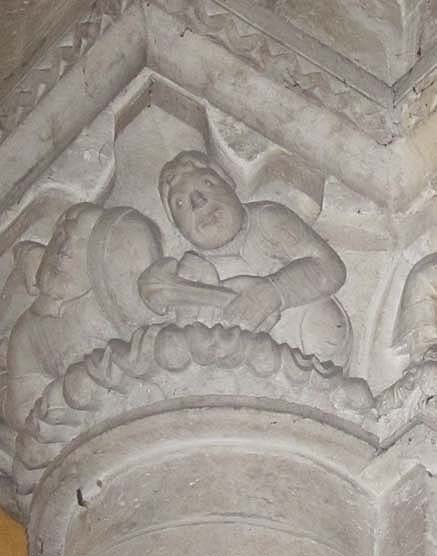
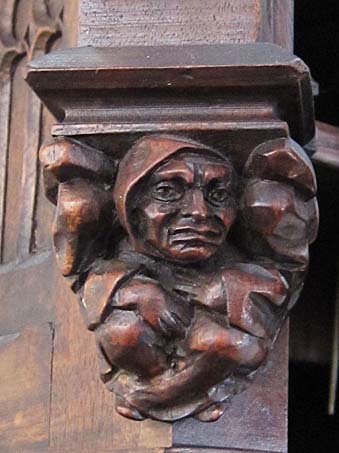
Fantastic animal figures such as griffins, dragons, and basilisks were especially loved by architects and furniture designers of the Gothic Revival.
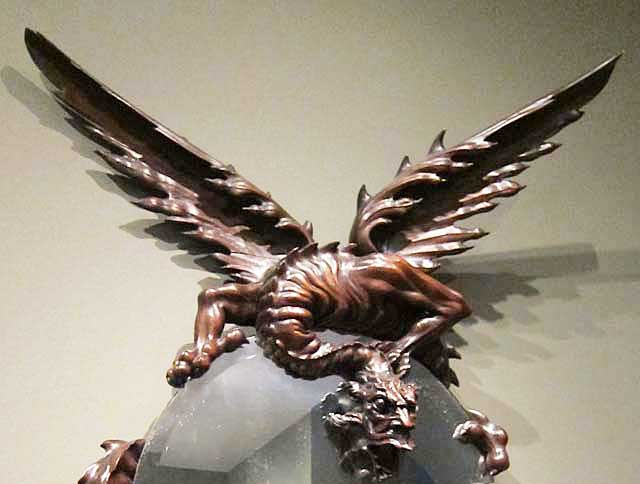
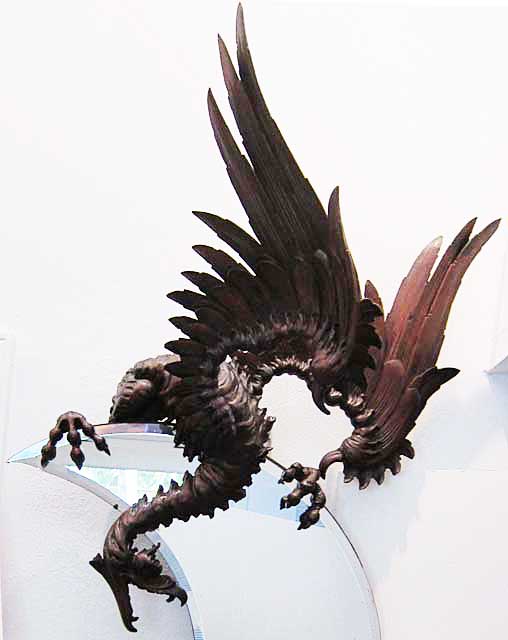
Combined in virtuosic exuberance, they are pleasing to the eye and captivating to the mind as they invite contemplation and celebration of each detail as well as the overall effect. Classified as grotesques (not to be confused with grotesque decoration in the Renaissance, as discussed below), these small statues, such as the ones gracing Notre Dame de Paris are either chimerae or gargoyles. The latter classification should apply only to those that act as water spouts, with the term reminiscent of the English verb "to gargle" and evoking the sound of rain water exiting the mouth of the figure.
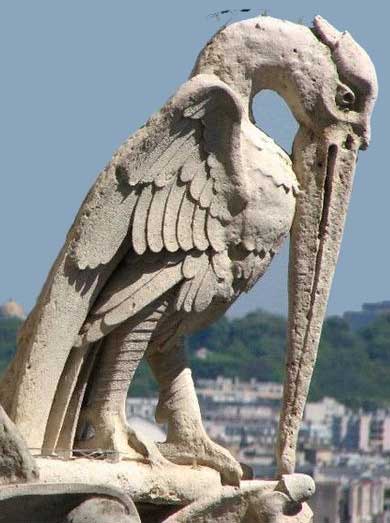
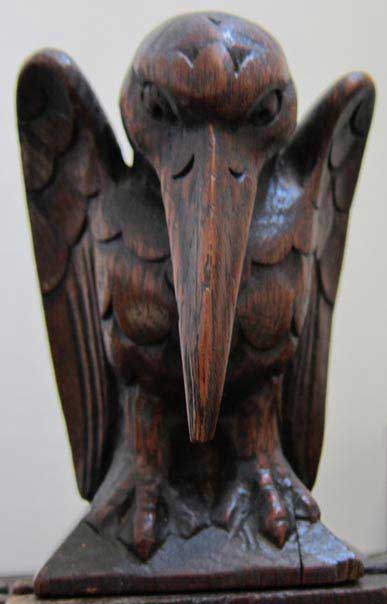
Unlike designs in the Middle Ages, all sorts of animals find their way onto furniture made during the 19th century revival. These include the "usual suspects" such as lions and dogs, whose symbolism is well understood. What we have found most intriguing are less obvious candidates for memorializing in carved oak or walnut. These include lizards, snails, swans, roosters, foxes, rats, caterpillars, frogs, serpents, and bats. We suspect that the fondness for these creatures may have arisen from examining medieval illuminated manuscripts such as the books of hours used for personal devotion in the Middle Ages and preserved in the Bibliothèque Nationale de France in Paris. In some examples, the animals are an intricate part of the elaborate designs that form a frame for the page.
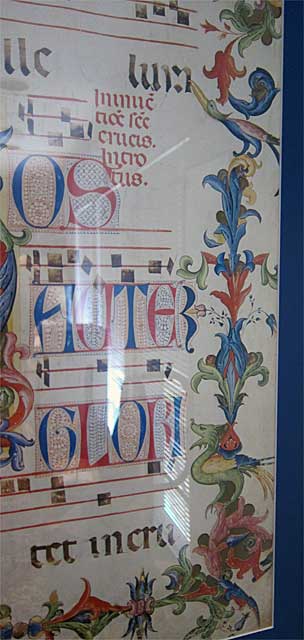

In other instances, the animals appear to be "doodles" added at the margins after the pages were initially illuminated. Either way, we expect that they inspired 19th century furniture designers to evoke the rich ornamentation found in illuminated manuscripts by populating their furniture with intriguing creatures.
For reasons we cannot explain, snails were especially popular in confrontations portrayed in the margins of manuscripts and also on furniture in our collection.

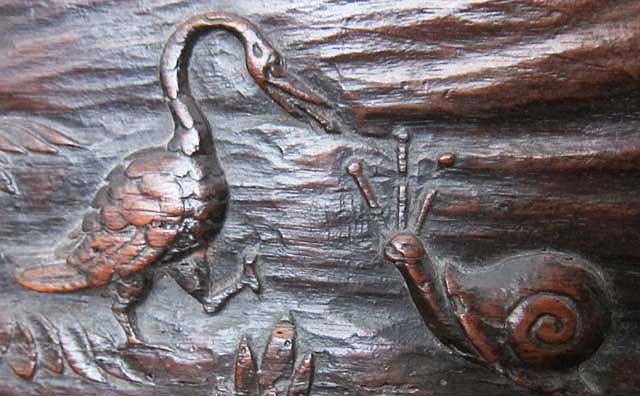
Much has already been published, especially in English, about the Gothic Revival in England – a movement encompassing the late 18th century and much of the 19th century. Not only did it include architecture and furniture, but also literature, painting and poetry. To its adherents it was superior to all other styles, not only artistically but morally. It embodied what it meant to be English, although contemporary skeptics noted that Gothic architecture originated in France and was exported to England at a time when the country’s Plantagenet rulers still conversed in French. Nevertheless, the Gothic Revival was firmly entrenched within the broader Romantic Movement as part of a yearning for distant historical times of myth and legend while promoting personal emotional expression over encroaching industrialization. Neo-Classicism, with its emphasis on the rational and on the remote pagan civilizations of ancient Greece and Rome, was swept aside by a rising tide of interest in individualism, nationalism, Christian religious fervor, and love of nature as embodied in the Gothic Revival.
The French revival of Gothic style, as interpreted in furniture, is clearly distinguishable from the English. At the risk of generalizing, English Gothic furniture has a more delicate and refined look and finish involving woods not used in the Middle Ages such as cherry, ash, and ebony. It is a re-interpretation of earlier styles to suit 19th century tastes and lifestyles rather than a faithful recreation of old pieces of furniture. French Gothic furniture, on the other hand, appears more massive and solid, faithfully replicating the pieces from the haute époque on view in many French museums and collections in the 19th century. For Gothic pieces incorporating tracery or fenestrage, the material of choice was oak as it was for medieval artisans.
For a fascinating peek into how French Gothic Revival furniture is the foundation for a contemporary American business, follow the link to Covington, KY.
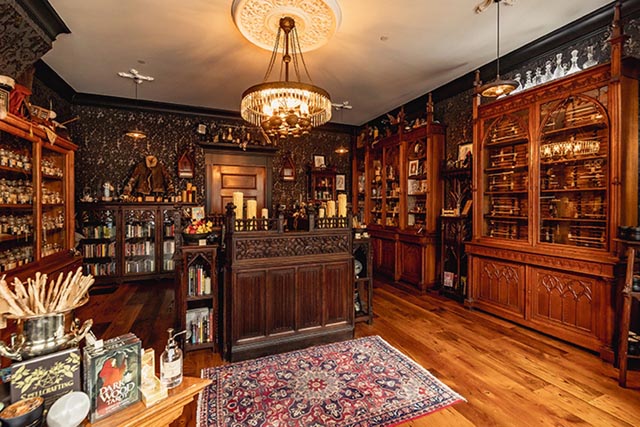
Renaissance
Particularly toward the end of the Middle Ages and as Renaissance design swept northward across Europe from Florence, furniture is characterized by the elaborate detail and exquisite ornamentation found in paintings and other works of art of that time period. A shift in overall style from Gothic arches and tracery to Renaissance elements took hold, signaling the "rebirth" of Roman designs from antiquity, including “grotesque decoration” inspired by long-buried rooms or "grottoes" comprising the ruins of Emperor Nero’s Domus Aurea. To the purveyors of this new style, decoration based on what was used by ancient Greeks and Romans was superior to anything supposedly imposed on France by rampaging Visigoths.
As Edmond Bonnaffé explains in his ground-breaking treatise of 1887, Le Meuble en France au XVI Siècle, a revolution in furniture-making occurred in the 15th century. Huchiers or artisans who "used a small ax" and specialized in making chests (the piece from which other types of furniture developed, as described below) split off from the guild of carpenters who "used a large ax" and constructed all manner of objects and dwellings from wood. Artisans using the small ax devised furniture made up of smaller panels on which elaborate ornamentation was carved, including arches and linen-fold panels. Cabinets became luxury items, especially at courts in Paris and Burgundy. Eventually, the title became huchier-menuisier for carpenters specializing in the joinery required for more refined furniture. Much of this adjustment of names and guilds was sparked by competition from the Italian woodworkers and furniture-makers arriving to work at the Chateau of Fontainebleau. These foreign craftsmen were resented as less qualified while taking the jobs of Frenchmen who had gone through the longer French training and qualifications involving a six-year apprenticeship.
At the same time, the "French School" of cabinet-making was exposed to the constantly shifting balance of influence between Flemish (under the patronage of the Dukes of Burgundy) and Italian styles. We know of the close ties between cities such as Bruges and Florence, due to banking and commerce, facilitating a sort of cross-pollination in the arts from furniture to painting to music. Eventually, and especially in the 16th century, Italian influence on furniture design won out over the Flemish to dominate throughout France.
While in the U.S. we generally view the Renaissance as a period of art running from the 14th to the early 17th centuries and radiating northward from Italy, French furniture experts make a distinction between the First Renaissance and the Second (la Première et la Seconde). The first runs from around 1490 to 1530-40 when French royalty were busy importing items from Italy and their French craftsmen were copying them — especially for chests and small cabinets. As Jacques Thirion points out in the introduction to the Première Renaissance in his book entitled Le Mobilier du Moyen Age et de la Renaissance en France, the furniture structures themselves changed little from Gothic. What swept in with the Renaissance style was an entirely new decorative vocabulary applied to the traditional categories of furniture. The style is characterized by swirling vegetation (rinceaux de volute), portraits in profile (medallions), grotesque decoration including arabesques and candelabras, columns and pilasters, as well as mythological figures and animal motifs such as dolphins and birds.
The Second Renaissance, from the mid-1500s to the end of the 16th century, is dominated by the innovations of the Fontainebleau School with an emphasis on large-scale pieces such as armoires and cabinets and on elaborate library tables. Spurring a complete re-invention of art in France for this Second Renaissance was King François I (reigned 1515-1547) and his passion for all things Italian. The Second Renaissance flourished especially during the reign of François' successor, King Henri II (reigned 1547-1559), whose Queen, Catherine de' Medici, was a Florentine and encouraged the styles and artisans of her homeland.
François I invited the Florentine artist, Rosso Fiorentino (1495-1540), to the hunting lodge of Fontainebleau to expand and renovate it. Installed at Fontainebleau and influencing French furniture designers for centuries to come, Rosso's masterpiece was the Galerie François I, including frescoes glorifying the king’s magnificence and framed by stuccoes introducing design elements such as strap-work, garlands of vegetation, and oodles of putti.
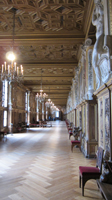
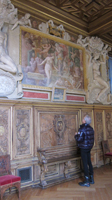

In fact, the king treasured this room so much that he founded a tapestry workshop at Fontainebleau to craft six tapestries based on Rosso’s work, so they could remind him of the Galerie and accompany him on extended visits to his other residences. These are now owned by the Kunsthistorisches Museum in Vienna.
Rosso was central to the adoption of Italian Renaissance style in France, not just in the frescoes and stuccoes in the Galerie François I but also from books of engravings made from his designs, influencing furniture makers for generations to come. These are among the works that 19th century artisans copied faithfully and, at times, sought to pass off as 16th century originals.
Thanks to Eugene Carroll, Professor Emeritus of Art History at Vassar College and developer of a website dedicated to Rosso Fiorentino, our knowledge of the development of furniture design in France has been greatly and fruitfully expanded. Rosso's innovations such as the use of strapwork or cuir découpé can be traced back to medieval times when pieces of leather were cut and arranged artistically as attachments to a flat surface such as a manuscript. Examples of our furniture evoking Rosso's stuccoes from Fontainebleau include Sgabelli 5334 and Mirror 9227.
Shortly after Rosso's death in 1540, a young Hugues Sambin (1520-1601) arrived at Fontainebleau for a stint of several years as a cabinet maker in the royal workshops. While there is apparently no surviving documentation of what he did there, the influence of Rosso and his successor, Primaticcio (1504-1570) is unmistakable in the masterpieces Sambin created later in his career while living in Dijon. Rosso's innovations in design, found in the stuccoes of the Galerie François I at Fontainebleau, were translated into walnut by Sambin. These include pediments, garlands of fruit and flowers, telamons, lions, scrollwork, strapwork, and putti. Drawings, prints, and engravings of Sambin's designs (as well as those of Jacques Androuet du Cerceau (1510-1584) and others) incorporating elements of Rosso's stylistic vocabulary, ensured that furniture makers in future generations would be inspired as Sambin had been. With Sambin and Androuet du Cerceau, we see the shift in the furniture business away from royal patronage to workshops owned by the designers and craftsmen themselves.
The key stylistic elements of the Renaissance are the rounded arch and other architectural elements, rectilinear designs mimicking perspective in painting, elaborate and broad mouldings, contrasting types of wood or marble inlays, emblematic animals such as lions, salamanders and porcupines, Roman armorial symbols, mythological figures portrayed in caryatids (females) and telamons (males also called atlantes), putti (playful figures of male children, often with wings) historical figures and biblical scenes depicted on panels, garlands, masques, chimeras, harpies, strapwork, nymphs, gods, and the ubiquitous acanthus leaf.

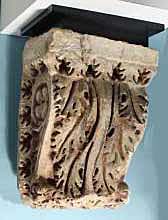
Another rediscovery from ancient times, linear perspective, became an important compositional tool for Renaissance artists, some of whom reveled in demonstrating their mastery of the technique (see Pinturicchio's Annunciation, in the discussion of grotesque decoration, below). As discussed more fully in the description of Chest 5227, furniture designers also excelled at creating a sense of deep perspective.
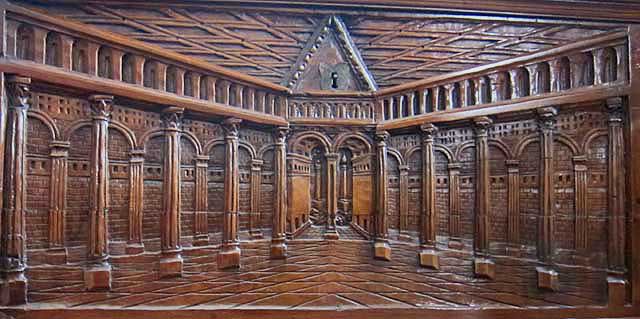
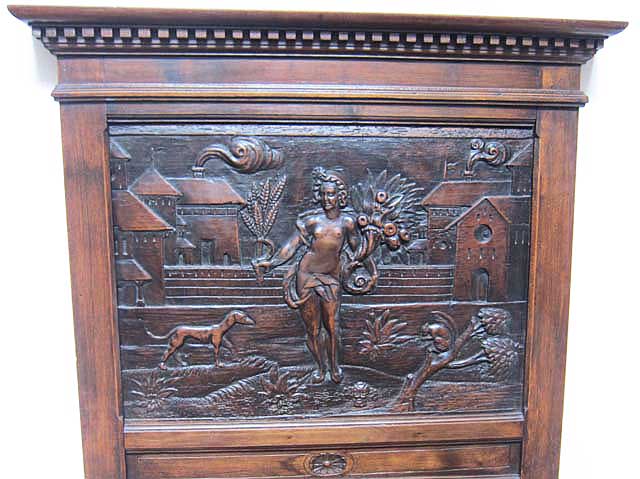
The material of choice for making furniture became walnut — more susceptible to intricate carving — instead of oak. As Bonnaffé observed, walnut was superior in terms of its finer grain, its tighter pores, its surface more rich and colored, more susceptible to polish, with the passage of time bestowing a rich patina.
An emphasis on symmetry and overall balance also characterize furniture of this period along with a sense of the individual owner whose taste it mirrors.
From Roman Grotto to Renaissance Grotesque
Grotesques and mythological allusions abound in Rosso's work and were deployed throughout the Renaissance by architects, painters, sculptors, and engravers. A key factor in the 19th century adoption of these design elements was the discovery and re-issuance of 16th century engravings, that had popularized the designs Rosso initiated at Fontainebleau, but using a new process called heliogravure. These design elements are seen throughout our collection, including the following items:
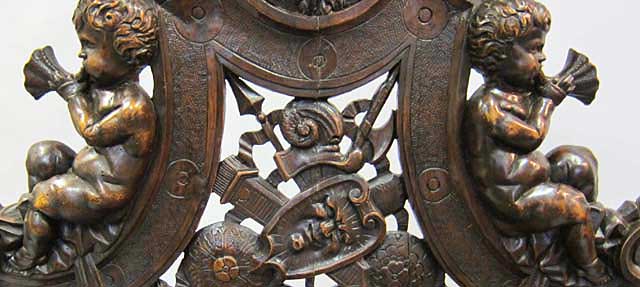
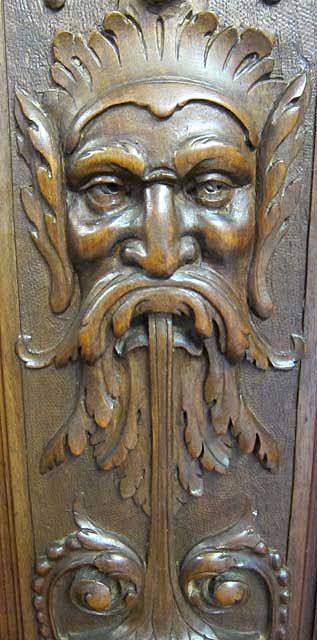
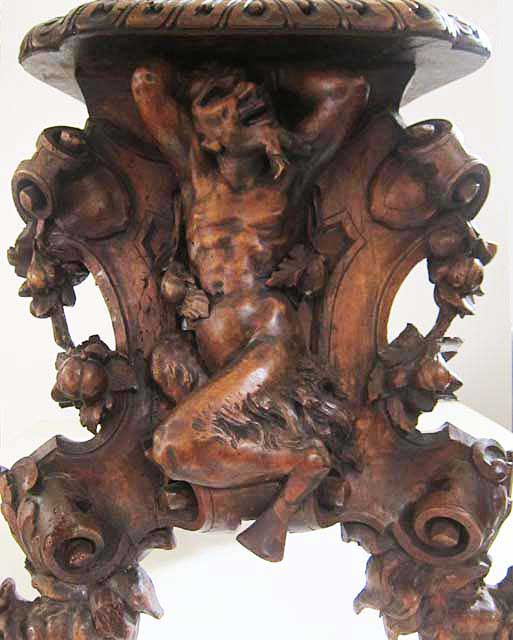
For that, we have the unearthing of Emperor Nero's Domus Aurea to thank. Nero's grand palace was supposed to take up a huge swathe of Rome after the fire of 64 A.D. but was only partially completed. It was later abandoned and eventually covered by other buildings. As the story goes, a young Roman fell into an underground chamber in the late 15th century and found some of the elaborately decorated rooms that had comprised Nero's palace. Thought to be underground caves or "grottoes" the identity of the long-buried palace was not immediately evident. Word spread about the magnificent frescoed decoration and so the leading artists of the day, including Pinturicchio and Raphael, had themselves lowered into the site on ropes while bearing torches to illuminate the subterranean masterpieces. Sadly, water and earthquake damage to the Domus Aurea make it more challenging for today's artists to visit, even without rope and torch, but the decorative bounty remains.
A decorative style became known as "grotesque," from its source in the mis-identified "grotto," and is characterized by panels filled with intricately entwined vegetation, animals, vases, garlands, and mythological beings, including masks with very scary visages. These last figures also took on the label "grotesque" and gave rise to the widely used term for something distorted, extravagant, and bizarre. The designs from Nero's palace became favorites of Renaissance painters when artists such as Carlo Crivelli, Pinturicchio, and Perugino incorporated them into biblical scenes, reflecting the heights of imagination and creativity to which a basic stylistic element can rise.
Pinturicchio's three frescoes for the Baglioni Chapel in the Church of Santa Maria Maggiore at Spello epitomize grotesque decoration, such as on the columns receding behind the scene of the Annunciation. To the right, is a self-portrait conveniently included by this Renaissance master. Nothing can compare to standing in this chapel, far off the beaten path of tourism, enthralled by every inch of his artistry while struggling to take it all in before running out of the one Euro coins needed to illuminate it.
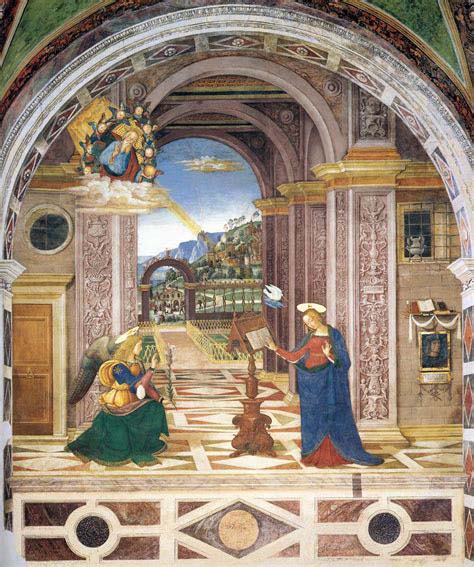
The result was not only a new array of decorative elements (volutes, tendrils, vases, candelabras, masques, acanthus leaves, festoons, etc.) used to fill space and to enchant the eye, but also a way of arranging these into integrated wholes such as the panels forming the back of our Throne Chair 5212. These new elements spread like wildfire throughout Italy and beyond.
Art historians have speculated that the wall and ceiling decorations rediscovered in the villas of ancient Rome, including the vast Domus Aurea built for Emperor Nero, were for private amusement. These are in contrast to the serious depictions of military victories, as well as gods and goddesses, found on arches, temples, columns, and on other public art around the city. Decoration alla grottesca in private homes had fantasy and diversion as its objectives. Included were figures suspended amidst larger-than-life props as well as male faces, later to be termed grotesques, of wild-eyed chaps with exuberant hair, flowing beards, and often with tongues hanging out of their mouths. Some of these faces appear as props or masques from theatrical works, depicted as details in larger scenes on the walls of homes. We photographed the following ones at the Museo Archeologico Nazionale in Naples when we visited in 2014.
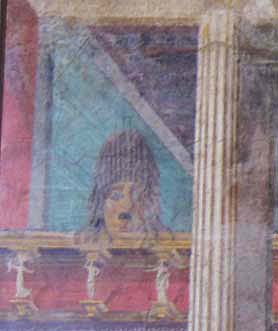
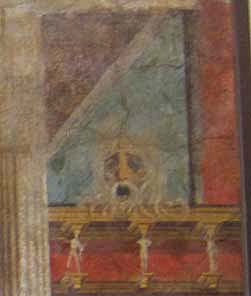

From the "grottoes" of ancient Rome came the "grotesque" decoration incorporated by Raphael into his designs for the Papal Apartments in Vatican City and the Villa Farnesina in Rome, by Pinturicchio in the frescoes of the Baglioni Chapel at Spello, and by Rosso Fiorentino in the Galerie François I at Fontainebleau. The Renaissance version of grotesque decoration is complex and seems to fill every inch of space, as demonstrated by Jacques Androuet du Cerceau in his treatise des Grandes Grotesques (1562). 19th century French cabinetmakers replicated it faithfully, so faithfully that some pieces were sold to collectors as being from the 16th century although they were newly made in the 19th.

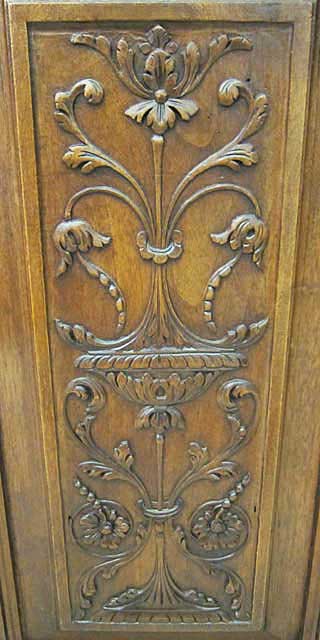
In contrast, the imperial Roman originals allowed much more open area around specific details such as the tendrils of vines.
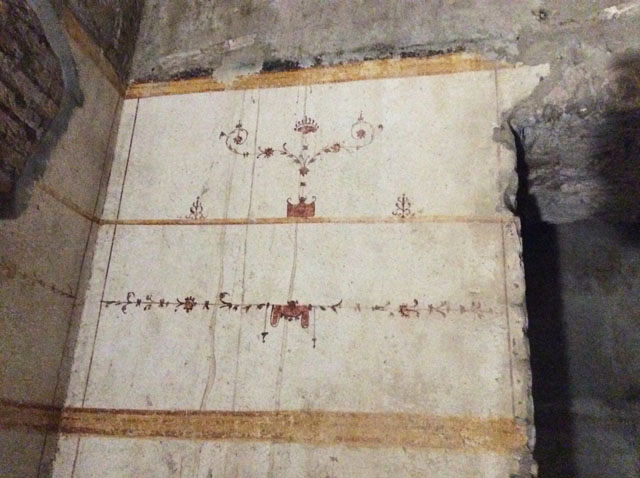
Inside Nero's Domus Aurea courtesy of Christoph von Teichman
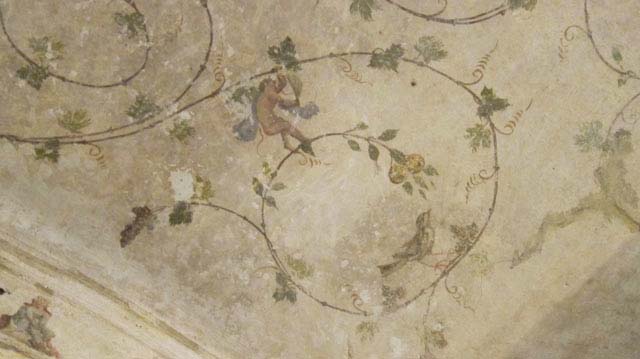
Ceiling decoration inside a tomb on the Via Appia
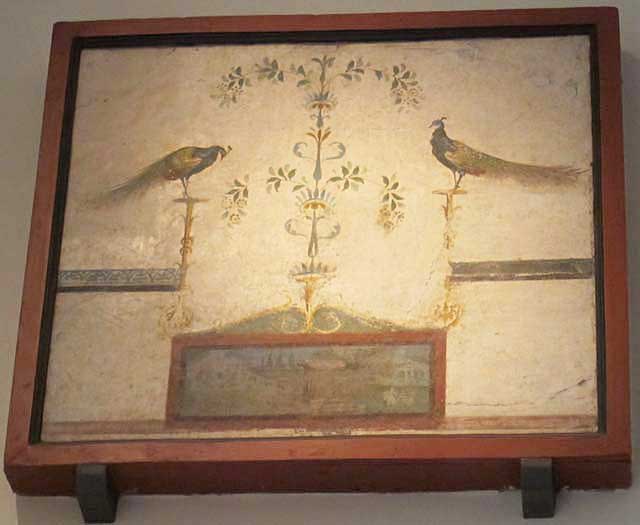
Grotesque design from a Roman era villa
The popularity of the designs used throughout Europe in the 16th century may also be a reflection of the influence of highly portable works of art, the ceramics or faïence known as maiolica whose brightly colored examples originated Italy. These designs, created in Urbino and other towns such as Deruta, Gubbio, and in Faenza (which gave rise to the term faïence in French for "ceramics") were adopted and further developed in the 19th century as shown in our collection of ceramics from factories at Gien and Blois.
Design elements typical of grotesque decoration have persisted since the Renaissance. Eruptions of enthusiasm and re-interpretation coincided with historical events such as the excavation of the ruins of Pompeii in the 18th century, enthusiasm for empire (and Neo-classicism) when Napoleon concurred Italy, and works of art brought home from grand tours to Italy undertaken by aristocrats from northern Europe.
Not all design motifs of the Renaissance have proved as easily traceable in their origins. One of the elements that most perplexed us was the use of what appear to be motifs from the native cultures of Central and South America including figures with elaborate feather headdresses, earrings, and costumes. These were especially popular in the hand-carved decoration of cabinets and armoires made for chateaus in the Loire Valley during the 16th century, as we first observed in items for sale from the Perrier Collection in 1992. The mystery was solved when we read about an exhibit at the Grand Palais in Paris in the spring of 2005 of artifacts of Brazilian Indians. Writing in the New York Times, Alan Riding related how the French were captivated by 50 Indians brought to France in 1550 and housed in a reconstructed Indian village in Normandy for the entertainment of royalty. From this exposure to New World culture, it is no surprise that French designers, always alert to trends in fashion, would choose to include these motifs in their furniture.
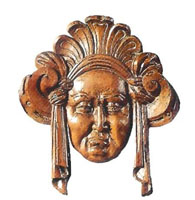
It is not inconceivable that at some point confusion arose as to any distinction between the masque characteristic of the grotesque style of design dating back to ancient Rome, and the mask and headdress combination inspired by the Brazilian Indians living in Normandy. Perhaps to the furniture designers, both were exotic and the distinction no longer made a difference.
The 19th Century Renaissance Revival in France
Renaissance style pieces from the 19th century tend to be of walnut, whose fine grain permitted highly intricate carving such as that created by 15th and 16th century craftsmen. An emphasis on architectural elements including arches, columns, pediments, trestles, and acanthus leaves characterized the 19th century revival of furniture constructed from solid wood, in contrast to 18th century construction techniques involving inlays, marquetry and veneers.
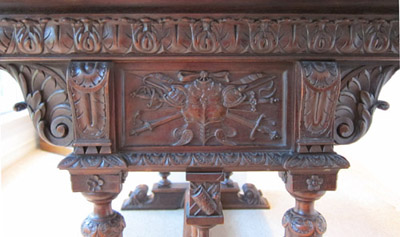
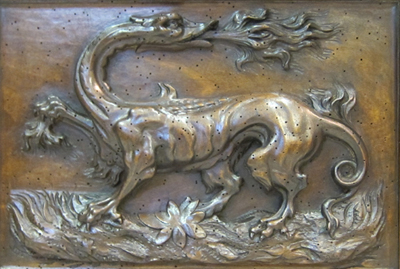

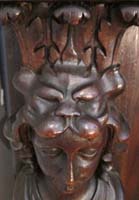
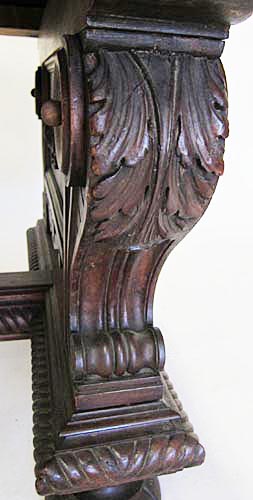
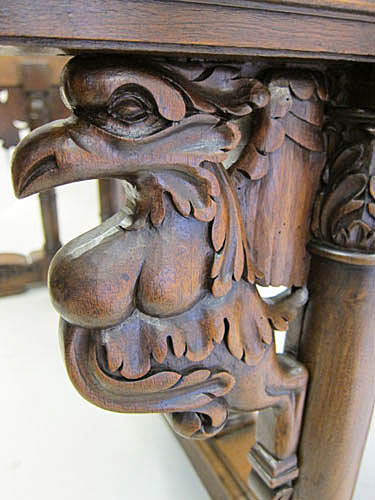
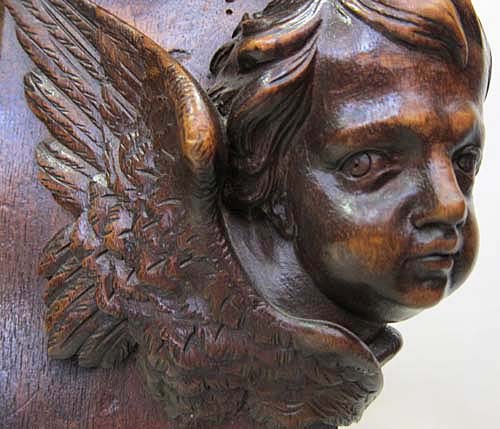
As we learned from a chance encounter on a Paris street corner, grotesque decoration was especially popular in the 19th century as part of the doors of houses in the city's upscale neighborhoods on the Right Bank. On several mornings during a recent trip to Paris, as we set out from our hotel to the Métro Madeleine, we observed a man on a ladder tracing the elaborate door of a building on the rue Tronchet. By the third day, our curiosity got the best of us and we asked him what he was up to. He explained that he was retired and now had the time to indulge his interest in Renaissance design. Having been given permission to make a sketch of the panel on this door, he was hoping to preserve it exactly and to scale. He said it was one of the few originals left in Paris. Although a bit camera-shy, we caught a photo of his sketch as he explained that he was surprised to find Americans who shared his passion. It is no wonder that these arabesque designs, characterized by central candelabra above a vase supported by putti and surrounded by swirling tendrils and exotic birds, would have inspired 19th century furniture designers as they strolled the streets of Paris.
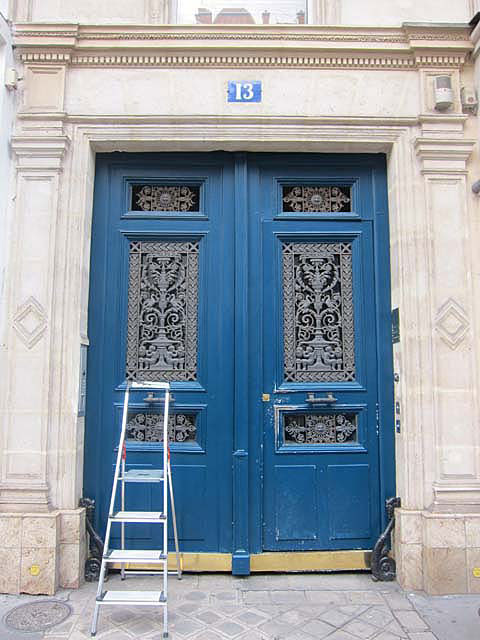
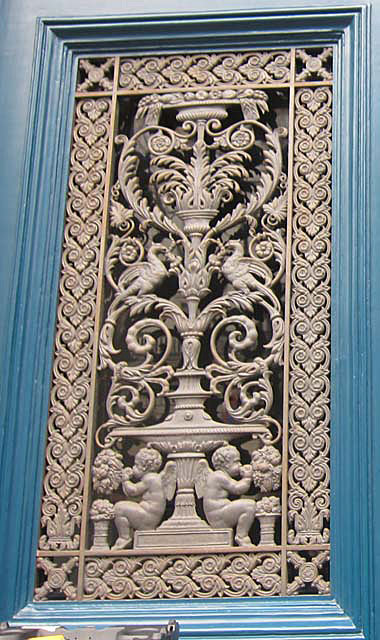
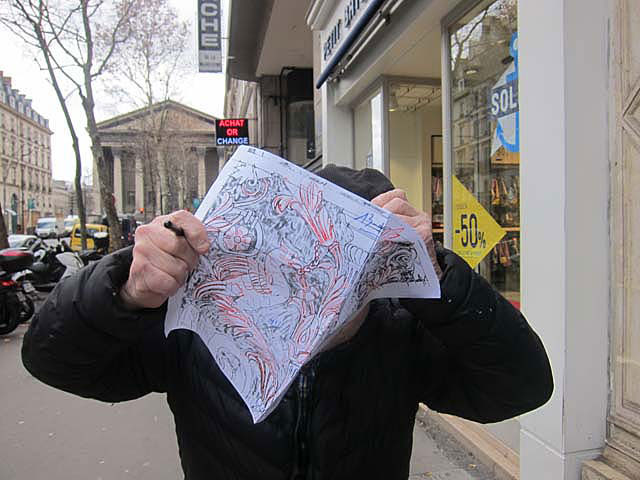
Beyond France, breakfast rooms in European hotels remain popular locations for appreciating grotesque decoration while sipping one's morning coffee. In the case of the Decumani Hotel de Charme, where we stayed during a business trip to Naples, the decor dates back to the 17th century when the palazzo was the residence of an archbishop. Of more recent construction is the Dom Pedro Palace Hotel in Lisbon, site of a tax conference I attended in 2016. Regrettably, the staff could offer no explanation about the origin of the enchanting grotesque decoration in the breakfast room and throughout this magnificent hotel.
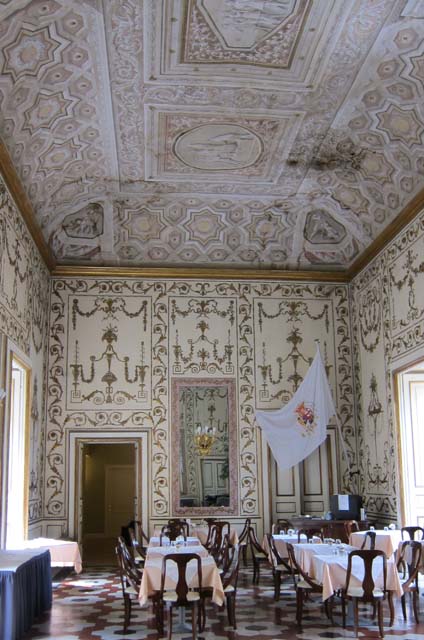
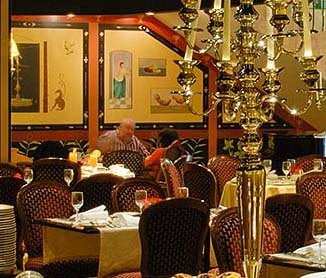
Today, we regularly encounter these same decorative motifs as witnessed during a recent bicycle ride through the Market Street shopping area, just five minutes from our home in The Woodlands, TX.

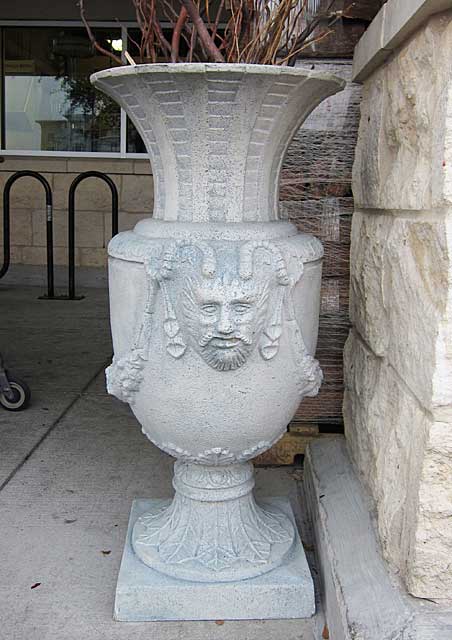
The following is an example of how French Renaissance Revival items have been used to create the welcoming environment of a library in a modern home.
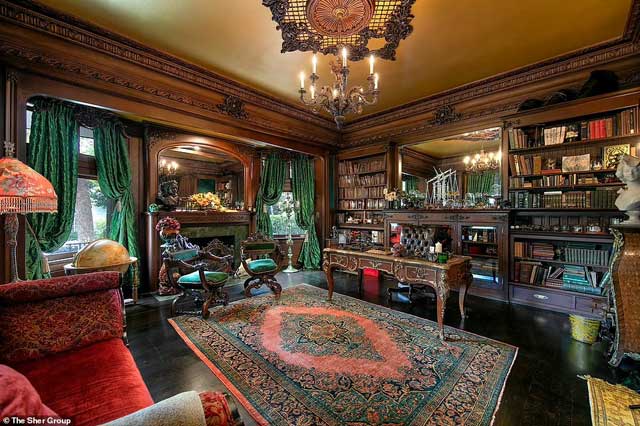
Because enthusiasm in the U.S. for these styles has outpaced the publication of scholarly materials, we have dedicated our website to expanding and enhancing the resources available in English on the 19th century revival in France of Gothic and Renaissance design. In this endeavor, we express our gratitude for their inspiration and guidance to three people connected to my alma mater, Vassar College, where my passion for Gothic Revival style was born: Professor Emeritus of Art History, Eugene Carroll (who passed away in 2016); Christopher Wilk, Keeper of Furniture, Textiles and Fashion at the Victoria & Albert Museum in London (Vassar Class of 1976); and Associate Professor of Art History, Andrew Tallon (who passed away in 2018 but whose work lives on in the restoration of Notre Dame de Paris). We are also greatly indebted to Martine Tissier de Mallerais, former curator of the Château de Blois and author of two books on the Renaissance style ceramics made at Blois, for her encouragement of our endeavors and for her generosity in sharing her vast reservoir of knowledge. For a long-overdue re-examination of French furniture of the Middle Ages and the Renaissance, we applaud the publication in 2019 of Mobilier du Moyen Age et de la Renaissance by Agnès Bos, who for ten years was Curator of Renaissance Decorative Arts at the Louvre.
After the discussion of categories of furniture, there is information on how to care for your antique furniture. For more information on the reference materials we used in preparing this page and in descriptions of our offerings, see the Bibliography section, below.
What follows are the stylistic origins of various categories of furniture offered on our website.
Chests
We adore chests or coffres because they were and remain the most versatile and adaptable furniture ever invented. A true "multi-tasker" for medieval times, a chest functioned as bed (for children or very small adults), table, or seat while securing all manner of worldly goods under lock and key. Not only was it the main item of furniture in early French households, it was not uncommon to have a chest in every room.
Tracing a chest's DNA to its ultimate ancestor shows that it began life in Roman times as a container for a soldier's weapons, often hewn from an entire tree trunk with a portion cut open and hinged to form the top (hence, chests also referred to as 'trunks'). Later Roman chests derived their style from the burial sarcophagus made of marble and heavily carved. Through the Dark Ages, the Middle Ages and into the Renaissance, the chest continued to have a security function -- housing the owner's valuables in a relatively portable form but strong enough to deter thieves. The French nobility led a semi-nomadic life traveling from one castle or home to another and taking their furniture with them. The portability and versatility of chests came in handy for transporting textiles and other valuables as well as serving as seats, tables and other functions on arrival at each location.
So many categories of furniture owe their development, during the Middle Ages, to the chest. For example, the armoire began as a chest standing on its end so the lid could swing to the side as a door. That staple of French dining rooms, the bahut-deux-corps, began life as two chests stacked on top of one another with their lids opening to the front. The dressoir cabinet evolved from a chest placed on a small table or platform. The bench is a chest with a back and arms added, while retaining the convenience of a storage area below the seat. Throughout the Middle Ages and Renaissance, chests were used to store prized culinary commodities such as salt and spices, keeping them not only safe from thieves but protected from vermin. In a smaller form, the coffret, the chest became a jewelry box or small yet secure container for housing highly portable valuables. The coffret took on its own decorative vocabulary associated with the style and wealth of its owner.
During the Gothic period in northern France, chests enjoyed their glory days -- borrowing from cathedrals such architectural elements as intricately carved arches and tracery (fenestrage) to become architectural masterpieces in their own right. Many of these pieces survive as faithful copies by 19th century craftsmen seeking to evoke the grandeur and elegance of earlier times.
In the Renaissance, the styles developed and perfected in Italy swept into Paris and the Loire Valley with Catherine de' Medici's entourage of craftsmen brought to the court of her husband, the future King Henri II of France. This decorative vocabulary, including vegetation and mythological figures, quickly supplanted the last remnants of Gothic style among the furniture makers of Northern France.
The coffre de mariage or wedding chest was also a popular form used by the bride to accumulate the linens to be used in marriage - not unlike the American concept of a "hope chest." Regional versions of the wedding chest were particularly popular in Brittany, often including likenesses of the bride and groom in carved panels on the front of the chest.
This versatility as well as a chest's portability helped ensure its popularity in the 19th century when French craftsmen sought to recapture the romance and chivalry of an earlier era - characteristics embodied in the chest as a cherished furnishing for the ages.
Click to view our Chests page.
Armoires
Our collection of French antique furniture has included armoires dating from the 18th to the 20th centuries in Renaissance, Henri II, Louis XIII and Louis XIV styles in solid oak or walnut. The collection includes a pair of matching bibliothèques or library cabinets with glass doors as well as a monumental Louis XIV armoire made in Provence in the 18th century. Like their medieval ancestors, these armoires are wonderfully versatile and command attention in whatever room they inhabit.
For centuries, armoires have commanded pride of place in French homes, treasured for their imposing presence and their ample storage capacity. Like most categories of furniture, the armoire traces its ancestry to the chest, from a time as far back as the Dark Ages when some clever French person turned a chest on its end and shoved it against a wall so that the lid would swing open as a door. The modern term "armoire" comes from the Latin word "armorium," or the chest that was used by Roman soldiers to store arms. From a cultural standpoint, this conversion from chest to armoire signals the beginning of a less nomadic and more prosperous lifestyle in which people no longer limited their furniture choices to whatever they could carry on their backs or their horses.
With war, pestilence, floods and crime as the common denominators of European existence for centuries, the armoire played a pivotal role in storing and protecting the possessions of its owner. In this context, it is important to remember that until the 19th century industrialization of the textile business, items such as rugs, tapestries, curtains, clothing, tablecloths, and bedding were extremely expensive and comprised the most valuable possessions of a household. Therefore a richly carved and massive armoire was a fitting repository to preserve and protect these trappings of wealth.
During Gothic and Renaissance times, the armoire was less popular than its cousin, also descended from the chest, the bahut-deux-corps or two-piece cabinet. Beginning with the reign of King Louis XIII in the 17th century, armoires reasserted their dominance as the premier category of furniture with bold designs featuring raised diamond patterns, Maltese crosses and other geometric shapes. Louis XIV's reign saw the development of the largest armoires in walnut, having massive architectural mouldings at top and bottom. Because of their solid and sturdy construction, many of these survive to this day, particularly in Southern France.
Most of our armoires date from the 19th century when France was swept by a passion for the revival of past styles such as Gothic, Renaissance (Henri II), Louis XIII and Louis XIV, leading to re-interpretations of the armoire for contemporary use. This gave rise to ingenious methods of construction so that armoires could be taken apart and re-assembled in rooms whose small doorways would not otherwise admit these giants. Craftsmen employed stylistic elements characteristic of the earlier periods such as columns, mythological creatures, and intricately carved vegetation. It was also the time when the bibliothèque or armoire with glass doors became popular for housing books in libraries and offices. These pieces are wonderful for showcasing collection such as ceramics.
On a recent visit to France, a young woman told us of the huge Louis XIV era armoire in the living room of her family's fifth floor apartment in central Paris and how it was a treasured member of the family. We asked if it was a problem moving it and she responded that she did not know - it had been in the same place for over 200 years! Such is the reverence and affection reserved for armoires in France that, although they are rare, we are able to find them so beautifully preserved.
In the U.S., the armoire has enjoyed a Renaissance of its own, including conversion into an "entertainment center" or the home for wide-screen televisions before they outgrew seven the largest armoires. This has led to a scarcity of the larger pieces of particularly solid construction with ample interior space.
Click to view our Armoires on the Cabinets page.
Cabinets
Our collection is rich and varied when it comes to cabinets - from small confituriers to massive, two-piece buffets dating from the 18th to the 20th centuries in styles including Gothic, Renaissance (Henri II), Louis XIII, and Louis XIV, crafted from solid walnut or oak. We were especially fortunate to acquire the entire collection of a retired French physician and devotee of French Gothic Revival furnishings who collected 19th century interpretations of Medieval cabinets featuring Gothic tracery and intricate statuettes.
Like the armoire, the cabinet traces its ancestry to the chest, which when turned onto its front or back panel and hoisted onto a platform became a cabinet with a lid which became a door. Two chests mounted on top of one another in this manner formed the original bahut-deux-corps or two-piece cabinet. As Bonnaffé tells us, when discussing the cabinet and armoire together, as distinguished from the dressoir, cabinets were used to lock up valuable items whereas the dressoir was used to display them.
The stylistic evolution of cabinets is a rich one, especially in the Middle Ages and Renaissance whose 19th century revival figures so large in our Château des Bois Collection. During the Middle Ages, cabinets served not only a storage function but also display. They grew ever larger in size as their owners sought more surfaces upon which to display silver, ceramics and other material indicators of their wealth and status. The need for horizontal display surfaces is directly responsible for the dressoir, a style of cabinet popularized in the Middle Ages and used throughout the Renaissance. The dressoir is a cabinet with a central case at eye level, usually having a door on either side of a central panel. Below the case is an open area with a pot board, a few inches above the floor, to display large items such as platters and vases. Examples of dressoirs can be found in numerous paintings and illuminated manuscripts from the Middle Ages and Renaissance, including works by Rogier van der Weyden and other Flemish masters.
In addition to a surprising number of dressoirs surviving from the Middle Ages and now in the hands of museums or private collectors, the 19th century revival of interest in Gothic furniture led to the creation of contemporary pieces which were faithful renderings of ancient models. Particularly striking are those employing tracery or fenestrage, to give the impression of Gothic architectural elements, and plis-de-serviette or plis-de-parchemin, the distinctive panels depicting a folded cloth or parchment. A taller, slimmer variation of the dressoir was developed, called the argenterie, to lock up the family's valuable silver (argent) in the central case while providing horizontal display surfaces above and below.
Renaissance craftsmen developed the dressoir further, including overt architectural elements for the basic structure, such as arches and columns, along with increasing use of an enclosed space at the bottom rather than the open pot board. But the pièce de la résistance of the Renaissance was the bahut-deux-corps - a massive undertaking of cabinet upon cabinet with the uppermost one often slightly narrower and crowned by a pediment. A band containing one or two levels of drawers and forming the top portion of the lower bahut was common. Although beautifully integrated, the bahut-deux-corps retained its identity as two cabinets coming apart for ease of transport. Such pieces were often covered in hand-carved decoration incorporating such elements as lions' heads, caryatids, mythological creatures, heraldic motifs, musical instruments, vegetation and portraits of the owners. Some even incorporated painted panels imitating Botticelli and other masters of the Italian Renaissance. The enthusiasm for the New World and the age of exploration was reflected in a style incorporating heads with feather headdresses and exotic flora such as corn. This is directly attributable to a sort of 16th century theme park created in Normandy by the ruling aristocracy and populated by 50 Indians from Brazil whose feather headdresses and elaborate earrings sparked a revolution in fashion and design reflected in the intricate carvings covering cabinets of the time.
Perhaps in reaction to this pervasive decoration, by the time of Louis XIII's reign in the 17th century, cabinets retained their architectural feel but ornamentation was geometric (diamond shapes) and placed a greater emphasis on the beauty and refinement of the wood itself. Size still mattered and, as in the case of the armoire, cabinets took on huge proportions and a commanding presence.
In addition to the bahut-deux-corps, other forms of cabinets were widely used in the 19th century revival of interest in the Gothic and Renaissance styles. For example, what we would today call a buffet or sideboard was a long, low cabinet or enfilade - taking its name from the Latin for "thread" and referring to the architectural device of stringing together a linear arrangement of interior doors. Of a more rustic character is the confiturier or cabinet for storing fruit jams and preserves. And for the sophisticated gentleman, there is the pantalonnière, a cabinet with doors behind which drawers emerge for laying out his array of trousers.
The 19th century in France saw a wide-ranging revival of the styles of earlier times and the adaptation of cabinets to meet regional tastes and modern uses. Our collection of cabinets represents some of the most beautiful and functional output of these craftsmen.
Click to view our Cabinets page.
Chairs
Perhaps more than any other category of antique furniture, the chair has had an overriding social function in addition to allowing us to take a load off our feet. Three-legged stools and benches without backs were used by those on the lowest rungs of society's ladder in early European times while the more fortunate had four-legged stools and benches with back rails for meals at long, communal tables. In the Middle Ages and Renaissance, high-backed chairs were used by the lord of the manor as his seat of authority, often raised on platforms. By Louis XIV's time, the styles of seating and their accouterments were highly detailed and regulated - an effective means of imposing and enforcing rank on courtiers at Versailles. Hangers-on were seated on large pillows while the nobility were permitted to sit on upholstered chairs with backs.
The earliest types of chairs include benches comprised of a chest with the addition of a back and arms. Such benches were typically arrayed around the entry hall of a castle or against the walls of the main reception room. Draped with fabric and covered in cushions, they were the ultimate in Medieval style and comfort. A further tweaking of the bench design for a single occupant became the chayère or chaire with a high back and solid arms and its cousin the cathèdre or bishop's seat. Tall chairs with high backs and sides had the advantage of protecting the sitter from drafts and of concentrating heat from the fireplace, as depicted in the illustrations to Viollet-le-Duc's 19th century treatise entitled Le Mobilier Médiéval (Medieval Furniture). Except when in use, the chairs were typically displayed with their backs up against a wall and hence the backs were unadorned. These fell out of favor by the mid-16th century in favor of benches without backs or with mere railings.
Apart from benches, early French chairs were variations on a Roman theme. For example, a style of chair whose history is as old as Europe itself is the "Savonarola" or "X" chair which evolved from the folding chair taken by the commanders of ancient Rome on their military campaigns. Later, after a French invasion of Tuscany, it became associated with their Florentine ally, Savonarola. The chairs named after the 15th century monk are still visible throughout his one-time home, the monastery of San Marco in Florence. In the 19th century these chairs enjoyed a resurgence of popularity, lending an unmistakable Gothic or Renaissance aura to a room.
Another popular design in the Middle Ages was the caquetoire - a wooden armchair with a narrow back and a trapezoidal seat. This shape is referred to 'as in the manner of Tallemouze' referring to a triangular puff pastry which was the ancestor of the modern cheesecake.
Especially in the dining room, the height of chair backs became important with the male head of household or the ancestry accorded the chair with the highest back. The next highest would be reserved for his wife. A particularly honored guest would be offered the host's chair placed at the head of the table.
The Italian Renaissance contributed several types of chairs that became popular in France and were made there, both in the 16th century and in the 19th century revival of Renaissance style. One is the Savonarola chair, an "X" shaped chair popularized in Florence but common in France. The other is the sgabello, a simple design that took on a life of its own as the basis for some of the most elaborate carving ever applied to a chair.
By the time of Louis XIII's reign in the 17th century, chairs were lighter weight and more open with padded seats and low backs and an "H" shaped stretcher forming a stable base. The long and prosperous reign of Louis XIV, however, saw greater variation along with elaborate carving and rich upholstery. The backs of chairs became higher, curving gently at the top and the arms took on a curved shape as well.
During the 19th century revival of interest in Gothic and Renaissance styles, benches and caquetoires were particularly popular. However, the need for the comfort afforded by dining chairs, as opposed to benches, led to the adoption of Gothic styling for dining room chairs. Backs of chairs lent themselves to the overall form of a Gothic arch enclosing an upholstered panel or hand-carved fenestrage (tracery).
Click to view our Chairs page.
Tables
Tables were perhaps the earliest indicators that a nomadic existence was waning in Medieval Europe. Large planks on saw-horses gave way to fabricated tables with central stretchers descended from the communal tables de monastère or refectory tables used in the dining halls of monasteries. Making possible shared meals and socializing cemented the importance of the table from the dawn of European history through to our own time.
Throughout the Middle Ages, the primary functions of the table were for eating and for displaying items. It was not until the Renaissance that tables began to be designed for more specific functions such as gaming and writing. As commerce played a more important role and cities grew, tables intended for a distinct commercial purpose, such as changing money or writing contracts, became more important and their design more elaborate. Drawers were introduced in the band just below the top and the bureau-plat was born. The term bureau comes from bure, a high-quality cloth draped over tables used by the keepers of the accounts at large estates and intended to distinguish it from the homespun, coarse woolen cloth used by less prestigious functionaries. By the early 17th century the term bureau had come to mean not only the reinforced cloth but also the table to which it was attached. From there, the person who sat at the table became the bureaucrat, giving rise to the institution known the world over, both collectively and pejoratively, as bureaucracy.
For residential uses, tables took on various forms. Most popular in the Renaissance was the "library table," whose width was approximately half its length, supported by a trestle of connected arches over an "H" shaped stretcher. Developed in Italy and known in France as the table à l'Italienne, it was inspired by tables made from marble in ancient Rome and called a cartibulum. Designed for pride of place in a library, these tables were magnificently carved from the finest, old growth walnut. Among the most beautiful were those of Jacques Androuet du Cerceau, whose engravings of tables and other furniture designs inspired generations of craftsmen.
The reign of Louis XIII saw the popularity of the writing table or bureau-plat with four legs in the form of torsades or twisted columns. Some of these tables were so large that they could fill the role of a modern dining or kitchen table. By the time of Louis XIV's long reign, tables were finding new forms such as ovals, circles and consoles, with more elaborate decoration.
During the 19th century, enthusiasm for furniture of the Middle Ages and Renaissance led designers to revive the styles of dining tables popular in the earlier periods but with additional emphasis on architectural features such as Gothic arches and tracery or Renaissance columns and arches. The revival also placed great emphasis on the beauty of the wood comprising the table top. Before the 19th century when the making of textiles was industrialized and prices dropped precipitously, the table had been less important and valuable than the cloth covering it and so there was little interest in what the top looked like. Aspects of this continued into the 20th century when leaves or extensions to tables were unfinished and of lesser quality wood with the expectation that they would be covered by a cloth when in use.
Other forms of tables include the guéridon, a small yet heavily-carved circular or octagonal top mounted on a central pedestal. Its cousin, the sellette, is taller and slimmer - designed to function as a pedestal or stand for objects such as plants, ceramics, silver, glass, or as a candelabrum for illumination.
It was not until the 20th century that such functional tables as the coffee table, end table or occasional table developed and so Gothic and Renaissance examples (or even their 19th century revivals) do not exist. While we have seen 19th century copies of ancient tables "modified" by shortening their legs to become coffee tables, we cannot condone this barbaric practice.
Smaller tables are readily adaptable for uses in modern homes. For example, the small table once known as a writing desk due to its central drawer for stowing stationery and ink, now serves better as a table between two beds or as a stand-alone table at bedside considering that mattresses are taller and therefore closer to the height of these tables.
Click to view our Tables page.
Fireplaces
Antique fireplaces made of wood are difficult to find and expensive to acquire. There are several reasons for this. First of all, unlike other items of furniture such as cabinets, armoires, etc., fireplaces were commonly made of stone rather than wood. Secondly, removing a fireplace from a building is tricky because they were designed and built in-place. Frequently, the only way to remove them is to destroy them in the process. As a result, we rarely see fireplaces come on the market and so we have fewer to offer than in other furniture categories.
Not only are wooden fireplaces rare, but those in the styles we favor are rarer still. The underlying reason could be the lack of fireplaces from the Middle Ages and Renaissance to inspire 19th century designers. During those earlier centuries, fireplaces would have been made exclusively from non-combustible materials such as stone. But since 19th century enthusiasts of the Gothic and Renaissance styles wanted contemporary pieces evoking design elements of the earlier periods, some fireplaces were made during the revival of interest in things Medieval and Renaissance.
The fireplaces we have offered have been made of walnut and hand-carved in what the French describe as the Henri II style - combining elements of both Gothic and Renaissance vocabularies. Characteristics include architectural features such as columns and arches as well as fanciful creatures such as lions and grotesques.
For modern buyers of 19th century fireplaces there is not only the problem of scarcity but size. Custom-built wooden fireplaces were designed with one location in mind and can create challenges when needing to accommodate the fire-box of a modern edifice. While we recommend that clients acquire the fireplace before the construction of a fire-box, this is not always possible.
With all these limitations in mind, we continue to search for fireplaces, especially those with armorial features and additional pieces above the mantle. Such fireplaces create a commanding presence in a room while enhancing the warm and inviting atmosphere created by a roaring fire.
Click to view our Fireplaces on the Décor page.
Michael Markley’s Views on the Care and Feeding of Antique Furniture
The piece you purchase will have been cleaned and waxed using products from Dugay in Paris. This is the traditional French method of caring for solid wood furniture and preserving the natural beauty of the wood. It is the only method recommended to care for fine French furniture. All that is required is occasional dusting and, every three to five years, a thorough waxing with Pate Dugay.
How to Dust
To dust, it is best to use specialty brushes (e.g., a horsehair shoe polishing brush) to access the intricate carving and to use a soft towel (the pile is the key) to gently clean flat surfaces.
Because gravity forces the dust downward, it is important to start at the top of your pieces and work your way down. If possible, have your air conditioning system running so that the dust particles are directed to the filter and less likely to resettle on the furniture.
Curves or columns that are close to the body of the furniture may require inserting a cloth between the column and the body of the furniture, moving gently back and forth.
Waxing
Furniture should require waxing only every three to five years, in conditions of normal usage. The French waxing process uses waxes matched to the color of the wood (considering whatever stains and finishes were applied at the time of creation) and is designed to combat the natural lightening effects of ultra violet light and preserve the original depth and richness of the wood.
Our recommendation is to use only traditional French colored waxes such as Pate Dugay (the solvent for which is either mineral spirits or paint thinner). Using a soft cloth, apply the wax to flat, non-carved surfaces. For details and carvings, use a natural fiber paint brush that is dipped into the wax and then painted evenly onto the details and carvings. Wax should dry at least an hour, depending on the humidity, and then buff the furniture with soft toweling on the flat surfaces and highlights of the carved surfaces. Use a special polishing brush for crevices and indentations of the carved and detailed surfaces. Brush and/or buff until the dull appearance of the wax gives way to the gleaming reflectivity of a well-waxed surface. The process is not unlike polishing shoes.
Patina
The waxing process inevitably results in wax deposits in the carvings and deep surfaces. This accumulated wax (and dust!) gives the pieces what is known as their patina. Having chosen the ideal wax color for the furniture, the result will be a long-term enhancement of the natural beauty of the wood and artistry of its creator.
Warning
Beware of products that talk about “feeding the wood.” This is impossible since the wood has already been sealed behind lacquers or shellacs, in place since the piece was created, and so products such as orange oil or “miracle products” of any kind cannot penetrate and only evaporate from the surface. However, they will cause dulling and they leave surface residues that gum up on the furniture and come off on anything that comes in contact with it.
Repairs
From time to time, antiques need repairs and other interventions to preserve structure and appearance. It is critical that these be undertaken only by experienced specialists familiar with the techniques and materials used by 19th century artisans. We rely on George Greider of Woodwork by George.
Bibliography
Ader-Tajan, Collection Bruno Perrier Haute Epoque (Catalog for Sale at Auction on April 6, 1992 at the Hotel Drouot, Paris)
Ader-Tajan, Collection Bruno Perrier Haute Epoque Deuxième Vente (Catalog for Sale at Auction on December 7, 1993 at the Hotel George V, Paris)
Aguttes, Haute Epoque Mobilier et Statuaire (Catalog for Sale at Auction on October 17, 2011 at the Hôtel Drouot, Paris)
Aldrich, Megan, Gothic Revival (Phaidon Press, London, 1994)
Antiquités et Objets D'Art 10, Le Mobilier Italien (Editions Fabri, Paris, 1990)
Antonucci Becherer, Joseph, Pietro Perugino (Grand Rapids Art Museum, 1997)
Avril, François, L’Enluminure à L’Epoque Gothique (Bibliothèque de L’Image, Paris, 1995)
Blakeslee, Arthur L., Ornament of the Italian Renaissance (Dover, 2007)
Boccador, Jacqueline, Le Mobilier Français du Moyen Age à la Renaissance, (Editions d’Art Monelle Hayot, Saint-Just-en-Chaussée, 1988)
Boccador, Jacqueline, Temple du Temps, (JMG, Paris, 2002)
Bonnaffé, Edmond, Le Meuble en France au XVI Siècle (Librairie de l'Art, Paris, 1887)
Borchert, Till-Holger, Flemish Primitives in Bruges, (Ludion, Ghent, 2006)
Bos, Agnès, Mobilier du Moyen Age et de la Renaissance — La Collection du Musée du Louvre (Editions du Musée du Louvre/Somogy, Paris, 2019)
Bos, Agnès, Decorative Arts/Furniture in Gothic Art in the Gilded Age (see, Brilliant, below)
Boussel, Patrice, Les Styles du Moyen Age à Louis XIV (Baschet et Cie, Paris, 1979)
Brilliant, Virginia, Gothic Art in the Gilded Age — Medieval and Renaissance Treasures in the Gavet-Vanderbilt-Ringling Collection (Ringling Museum of Art, Sarasota, 2009)
Brooks, Chris, The Gothic Revival (Phaidon Press, London, 1999)
Burckhardt, Monica, Mobilier Moyen-Age, Renaissance (Editions Ch. Massin, Paris, Undated)
Camille, Michael, Image on the Edge — The Margins of Medieval Art (Reaktion Books, London, 2021)
Carroll, Eugene A., Rosso Fiorentino, Drawings, Prints, and Decorative Arts, (National Gallery of Art, Washington, D.C., 1987)
Carroll, Eugene A., Rosso Fiorentino — Paintings, Drawings, Prints, and Architecture, (Online from Vassar College, Poughkeepsie, 2016)
Cassar, Robert, Armour and the Lure of Classical Pattern, in Ornament and Malta (Heritage Malta, Valletta, 2011)
Charles, Corinne, Victor Hugo — Visions d'Intérieurs, du Meuble au Décor (Paris-Musées, Paris, 2003)
Chastel, André, Discovering Intarsia, (Franco Maria Ricci No. 26, 1987)
Clark, Kenneth, Civilisation, (Harper & Rowe, New York, 1969)
Costantino Fioratti, Helen, Il Mobile Italiano (Giunti Editore, Firenze-Milano, 2004)
Crépin-Leblond, Thierry, Le Roi et L'Artiste (Réunion des Musées Nationaux, Paris, 2013)
Crosby, Alfred W., The Measure of Reality — Quantification and Western Society, 1250-1600 (Cambridge University Press, 1997)
De Seta, Cesare, The City in Perspective — The Urban Image: Real and Ideal, FMR (May-June 1987 English Edition)
Dulong, Claude, et al, Un Temps d’Exubérance — Les Arts Décoratifs sous Louis XIII et Anne d’Autriche, Paris, Galeries Nationales du Grand Palais (Réunion des Musées Nationaux, Paris, 2002)
Erlande-Brandenburg, Alain, et al, Hughes Sambin - Un Créateur au XVI Siècle (Réunion des Musées Nationaux, Paris, 2001)
Etude Tajan, Haute Epoque (Catalogue for Sale at Auction on September 24, 2003 at the Hôtel Drouot, Paris)
Faton-Boyancé, Jeanne (Ed.), Le Symbolisme du Bestiaire Médiéval Sculpté (Editions Faton, Dijon, 2010)
Faton-Boyancé, Jeanne (Ed.), Louvre Trésors du Moyen Age (Editions Faton, Dijon, 1993)
Faton-Boyancé, Jeanne (Ed.), Trésors de l’Art Médiéval — Le Musée de Cluny Devient Musée National du Moyen Age (Editions Faton, Dijon, 1992)
Faton-Boyancé, Jeanne (Ed. et al), Trésors de la Renaissance au Château d’Ecouen (Editions Faton, Dijon, 1997)
Fiocco,Carola, et al, Majoliques Italiennes du Musée des Arts Décoratifs de Lyon (Editions Faton, Dijon, 2001)
Fligny, Laurence, Le Mobilier en Picardie 1200-1700 (Picard Editeur, Paris, 1990)
Fuccella, Antonia, Umbrian Furniture 15th to 18th Century (Editrice La Rocca, Marsciano, 2005)
Gairaud,Yves, Le Guidargus du Meuble Régional (Les Editions de l’Amateur, Paris, 1990)
Goldthwaite, Richard A., Wealth and the Demand for Art in Italy 1300-1600, (Johns Hopkins University Press, Baltimore, 1993)
Grenon, Thomas (Ed.), France 1500 — Entre Moyen Age et Renaissance (Réunion des Musées Nationaux, Paris, 2010)
Haraucourt, Edmond, Catalogue des Bois Sculptés et Meubles (au Musée des Thermes et de l'Hôtel de Cluny) (Musées Nationaux, Paris, 1925)
Havelock, Christine Mitchell, Hellenistic Art (W.W. Norton, New York, 2d ed., 1981)
Jardine, Lisa, Worldly Goods — A New History of the Renaissance (Doubleday, New York, 1996)
Kisluk-Grosheide, Danielle, et al, Salvaging the Past: Georges Hoentschel and French Decorative Arts from The Metropolitan Museum of Art (Metropolitan Museum of Art, New York, 2013)
Lightbown, R. W., Carlo Crivelli (Yale University Press, New Haven, 2004)
Mack, Rosamond E., From Bazaar to Piazza — Islamic Trade and Italian Art 1300-1600 (University of California, 2001)
Mannoni, Edith, Mobilier Lyonnais (Editions Massin, Paris, 1995)
Monnas, Lisa, Merchants, Princes and Painters — Silk Fabrics in Italian and Northern Paintings 1300-1550, (Yale University Press, New Haven, 2008)
Morrison, Elizabeth and Anne D. Hedeman, Imagining the Past in France (J. Paul Getty Museum, Los Angeles, 2010)
Oliver, Lucile, Reconnaître les Styles Régionaux (Editions Massin, Paris, Undated)
O'Malley, Michelle, The Business of Art — Contracts and the Commissioning Process in Renaissance Italy (Yale University Press, New Haven, 2005)
Piat, Florence, Les stalles de l’ancien Duché de Bretagne, (L'Université Européene de Bretagne, Rennes, 2012)
Picón, Carlos A., et al, The Art of the Classical World in the Metropolitan Museum of Art (Metropolitan Museum, New York, 2007)
Quette, Anne-Marie, Le Mobilier Français Louis XIII et Louis XIV (Editions Massin, Paris, 1996)
Picón, Carlos A. et al, Art of the Classical World in The Metropolitan Museum of Art (Metropolitan Museum, New York, 2007)
Pyhrr, Stuart W., Of Arms and Men — Arms and Armor at the Metropolitan, (Metropolitan Museum, New York, 2012)
Racinet, Auguste, Full-Color Picture Sourcebook of Historic Ornament (Dover Publications, New York, 1989).
Raggio, Olga and Antoine M. Wilmering, The Liberal Arts Studiolo from the Ducal Palace at Gubbio (Metropolitan Museum of Art, 2004)
Rousseau, Francis, Le Grand Livre des Meubles (Copyright Studio, Paris, 1999)
Rouyer, Eugène (Ed.), French Architectural Ornament from Versailles, Fontainebleau and Other Palaces (Dover Publications, New York, 2007)
Saglio, André, French Furniture (B.T. Batsford, 1913)
Salmon, Xavier, Fontainebleau - Le Temps des Italiens, (Editions Snoeck, Gand-Courtrai, 2013)
Sandron, Dany and Andrew Tallon, Notre Dame Cathedral — Nine Centuries of History (Translation into English by Lindsay Cook and Andrew Tallon of 2013 edition, Pennsylvania State University Press, 2020)
Sargentson, Carolyn, Merchants and Luxury Markets — The Marchands Merciers of Eighteenth-Century Paris (Victoria & Albert Museum, London, 1996)
Scarpellini, Pietro and Maria Rita Silvestrelli, Pintoricchio (Mederico Motta Editore, Milan, 2003)
Sebregondi, Ludovica, and Tim Parks, Denaro e Bellezza — I Banchierei, Botticelli e il Rogo delle Vanità, Catalogue of Exhibition at the Palazzo Strozzi, Florence (Giunti, 2011)
Seta, Cesare de, The Urban Image: Real and Ideal (Franco Maria Ricci No. 26, 1987)
Smeyers, Maurits, L'Art de la Miniature Flamande du VIIe au XVIe Siècle (La Renaissance du Livre, Tournai, 1998)
Stemp, Richard, The Secret Language of the Renaissance, (Duncan Baird, London, 2006)
Thirion, Jacques, Le Mobilier du Moyen Age et de la Renaissance en France (Editions Faton, Dijon, 1998)
Tissier de Mallerais, Martine, Cent Ans de Faïence à Blois (Château de Blois, 1978)
Tissier de Mallerais, Martine, Entre Perche et Sologne — Images des Saints en Loir-et-Cher (Rencontre avec le Patrimoine Religieux, 2019)
Tissier de Mallerais, Martine, La Faïence de Blois, (Berger M. Editions, Vicq-Exemplet, 2017)
Vanlian, Laurent and Cédric Curien, Dream of the Dragon (Arts Asiatique, Paris, 2012)
Viollet-le-Duc, Eugène, Le Mobilier Médiéval (Georges Bernage, editor) (Editions Heimdal, Bayeux, 2003)
Wainwright, Clive, The Romantic Interior (Yale University Press, New Haven, 1989)
Ward-Jackson, Peter, Some Main Streams and Tributaries in European Ornament from 1500 to 1750 (Victoria and Albert Museum, London, 1969)
Wardropper, Ian, The Flowering of the French Renaissance (Metropolitan Museum of Art, New York, 2004)
Watson, Wendy, Italian Renaissance Ceramics, (Philadelphia Museum of Art, Philadelphia, 2001).
Wenzler, Claude, Architecture du Château Renaissance (Ouest-France, Rennes,1999)
Wilk, Christopher, Western Furniture 1350 to the Present Day (Cross River Press, New York, 1996)
Williamson, Paul and Peta Motture (Eds.), Medieval and Renaissance Treasures (V&A Publishing, London, 2010)
Wixom, William (Ed.), Mirror of the Medieval World (Metropolitan Museum, New York, 1999)
Zamperini, Alessandra, Ornament and the Grotesque (Thames & Hudson, London, 2008)
*This information may be freely copied and disseminated, providing attribution to M. Markley Antiques is included.
